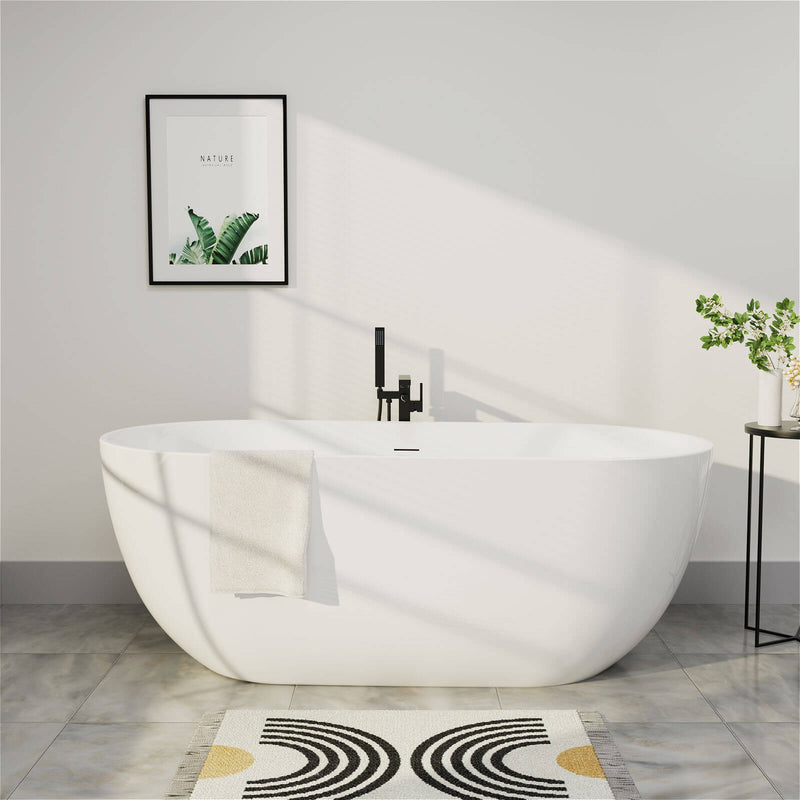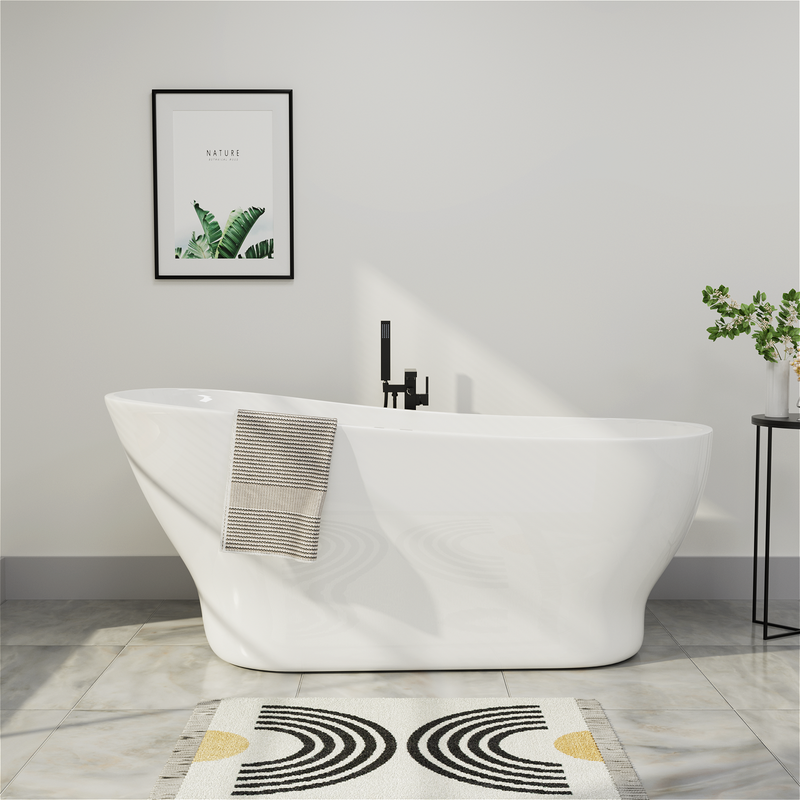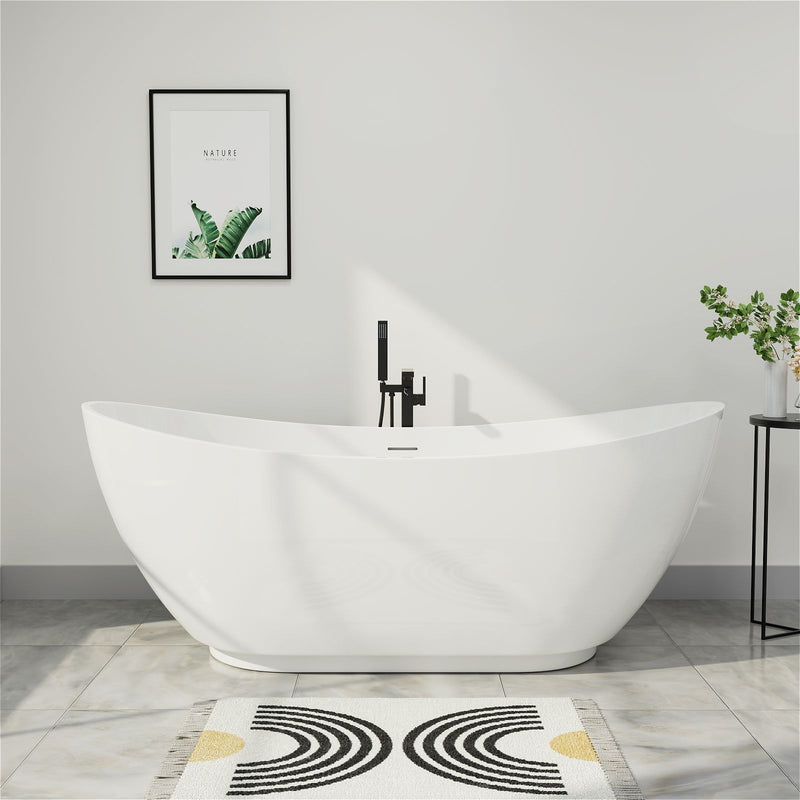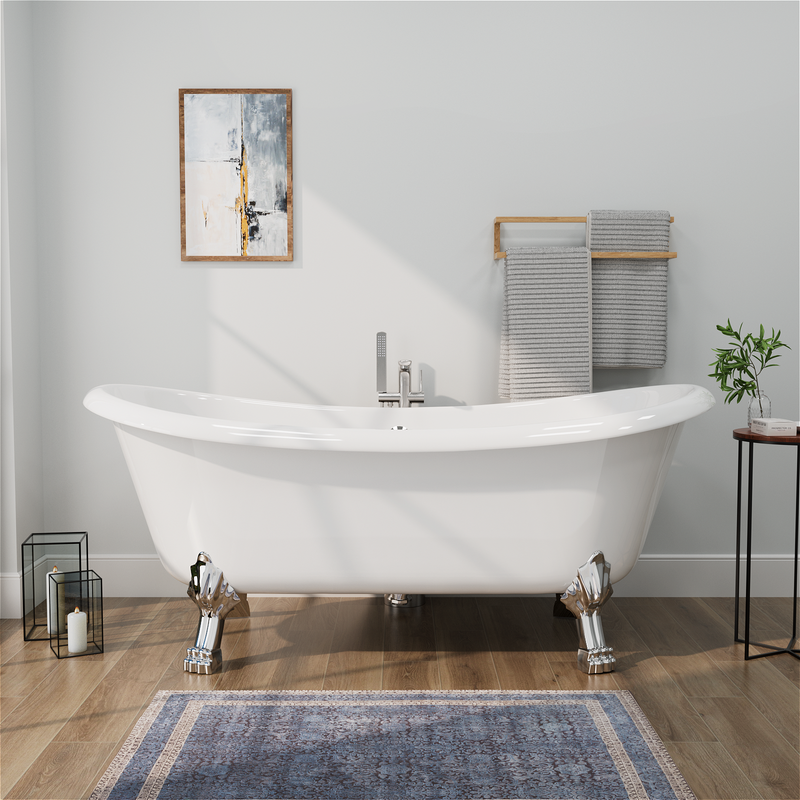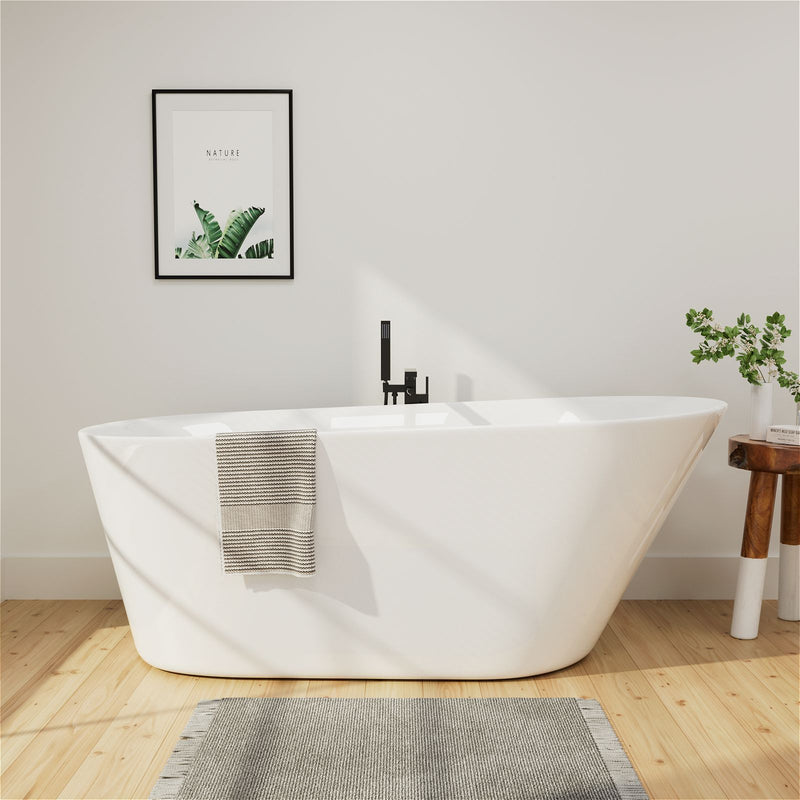A tub surround is essentially a fixed structure, a single or three-panel installation mounted on the wall above the tub, surrounding the tub area and extending up the tub walls to protect against splashes, spills, and steam. They can be simple flat panels or elaborate installations with textures and shelves. They are often made of materials such as acrylic, fiberglass, or even tile, and are designed to prevent water from entering the tub walls and help prevent moisture damage and mold growth.
Tub Surround Materials
Choosing the right tub surround material is key to balancing durability, aesthetics, and budget. Here are some of the most popular choices, including their benefits and considerations.
Acrylic Bathtub Surrounds
One-piece acrylic bathtub surrounds are popular because they are affordable, durable, and easy to maintain. Their non-porous surface effectively prevents mold growth and is a breeze to clean. Unlike some materials, acrylic is not easily chipped, providing a long-lasting and durable solution for busy bathrooms. And it is lightweight, which is generally quicker to install, minimizing disruption to daily life.
Tile Bathtub Surrounds
Tile bathtub surrounds are ideal if you want to create a personalized look. Tile has dominated the industry for decades due to its versatility and rich design options. From ceramic to porcelain, tile comes in a variety of colors, patterns, and textures, allowing you to create a personalized look that is unique to your bathroom.
However, the charm of tile also comes with some heavy maintenance needs. Unlike acrylic, tile's caulk lines need to be cleaned regularly and occasionally resealed to prevent moisture accumulation. Tile is also more likely to chip after being hit. Although the caulk lines are subtle, they are prone to mold growth, which can get trapped in the porous surface and may even spread under the tile. Because of this, tile is difficult to maintain over time and is more laborious to clean. In addition, tile is one of the more expensive enclosure materials.
Fiberglass Bathtub Surrounds
Fiberglass bathtub surrounds are a good choice for those looking for an affordable and lightweight tub surround. They are usually available in pre-made kits, which are quick and easy to install. Fiberglass is moisture-resistant and lightweight, which means it is easier to handle during installation.
The downside is that fiberglass is more susceptible to scratching and cracking than other materials, such as acrylic. While it costs less upfront, it may soon need repair or replacement if not properly maintained.
Natural Stone Bathtub Surrounds
Natural stone tub surrounds can be made from granite, marble, slate, or limestone - all of which are known for their beauty and high price tags. These materials tend to be heavier and more difficult to install than other tub surrounds. Additionally, their earthy nature makes them more susceptible to damage from daily use, making it particularly difficult to prevent stains and scratches.
Why Do You Need a Tub Surround?
A bathtub surround is a great choice for homeowners looking to renovate their bathroom. Not only does it combine practicality and style, it also provides a durable solution that will protect your space for the long term. Here's why they're so popular for bathroom renovations.
Prevents Water Damage
One of the biggest benefits of a bathtub surround is its ability to protect your walls from water damage. By creating a barrier between the walls and the constant splashing of showers and tubs, bathtub surrounds help prevent moisture from seeping into the structure of your bathroom. This minimizes the risk of mold growth, which is often a costly and time-consuming process to resolve.
Elevate Your Bathroom Style
What's better than adding a feature that will protect your bathroom for the long term? Add one that looks great. Available in dozens of materials, colors, and finishes, bathroom surrounds create a simple, sophisticated look that instantly elevates the modern feel of your space. Whether you want a minimalist aesthetic or a more personal, luxurious feel, a new surround can give your bathtub area a fresh look and become a visual focal point in your bathroom.
Choose the Right Tub Surround
Choosing the perfect tub surround means finding a balance between style, function, and the unique needs of your space. Here's how to pick the right tub surround for your bathroom.
Assess Your Space
Before deciding on a tub surround, take a close look at the layout and size of your bathroom. The size of your space plays a big role in determining the best type of surround. For smaller bathrooms, a simple, clean-lined acrylic or fiberglass surround can create an open feel without making the room look too crowded. If you have more space, a custom tile surround can add texture and personality to make the most of a larger space.
Match Bathroom Decor with Bathtub Surrounds
A bathtub surround should complement the overall design of your bathroom and create a harmonious atmosphere. So consider your existing color scheme and existing materials in your bathroom. If your space is designed with sleek lines, a sleek acrylic surround may be the perfect match. Think about the overall mood you want to create - whether it's calming neutral or bold and dynamic - and choose a bathtub surround that enhances the overall look.
Low-Maintenance Benefits
Another benefit is low maintenance. Acrylic bath surrounds are non-porous, which means they are naturally resistant to mold, mildew, and stains - no need to scrub or use specialized cleaners. Acrylic bath surrounds are ideal for busy families and retirees who want a beautiful bathroom without the added maintenance. Simply wipe the surface with a mild detergent and it will stay as new as the day it was installed.
Bathtub Surround Cost Considerations
Investing in a bathtub surround is a great way to give your bathroom a fresh look without having to completely remodel it, but it's important to understand what you're spending money on and how to budget for the upgrade. These are the key factors that affect the cost of a new bathtub surround, and how to get the most out of your investment.
Factors That Affect the Price
The overall cost of a bathtub surround is affected by a number of factors, starting with the choice of material. Prefabricated acrylic and fiberglass surrounds are generally more affordable, while custom tile or solid wood surfaces can cost more due to their custom nature.
The size of your bathtub is also important - larger bathtubs or custom-shaped spaces may require additional materials or special adjustments. Customization options, such as adding built-in shelves or decorative moldings, can also affect the final price.
Cost vs. Lifespan Comparison
While the upfront cost is important, the long-term savings of a high-quality bathtub surround are also worth considering. Durable materials like acrylic can save you money in the long run due to their long life and low maintenance needs. Investing in a better bathtub surround now means you're less likely to need to repair or replace it later, keeping your bathroom looking great for years to come.
Waterproofing Your Bathtub Surround
Proper waterproofing is essential to preventing water damage and mold growth around your bathtub. There are several options to ensure your bathtub surround remains waterproof and resilient for years to come. Let's explore each waterproofing option:
Seal the Seams
One of the most basic but critical steps to waterproofing your bathtub surround is to thoroughly seal all of the seams. This requires the use of a high-quality silicone caulk designed for wet areas. Make sure all gaps between the tub, walls, and surrounding fixtures are sealed tightly to prevent water seepage.
Waterproofing Membranes
Using waterproofing membranes is an effective way to effectively prevent moisture penetration. These membranes are usually made of materials such as PVC or rubber and are installed directly on the wall before installing the tub surround. They provide extra protection and peace of mind, especially in areas prone to water intrusion.
Liquid Waterproofing Sealants
Liquid waterproofing sealants are applied directly to the surface of the tub surround to create a waterproof barrier. These sealants come in a variety of forms, including brush-on coatings and spray-on solutions. They are easy to apply and are effective in sealing seams, joints, and porous surfaces.
Sheet Waterproofing Membranes
Sheet waterproofing membranes, also known as waterproofing underlays, are thin, flexible sheets made of materials such as polyethylene or rubber. They are laid on the tub surround before laying tiles or installing the tub surround. Sheet waterproofing membranes have excellent waterproofing properties and are especially suitable for shower areas with high moisture environments.
By incorporating one or more waterproofing options into your tub surround installation, you can rest assured that your bathroom will remain dry, clean, and free from water damage for years to come.
Tub Surround Maintenance Tips
Ensuring your tub surround lasts and looks great requires ongoing maintenance. Here are some important maintenance tips to keep your acrylic tub surround looking its best:
Regular Cleaning
Clean your tub surround regularly using a mild detergent and a soft sponge or rag. Avoid using abrasive cleaners or scouring pads that can scratch the surface.
Preventative Measures
Take precautions to avoid damage, such as using a bath mat to prevent scratches and dents from heavy objects.
Avoid Harsh Chemicals
Do not use harsh chemicals or abrasive cleaners on acrylic tub surrounds, as they can cause damage and discoloration.
Gentle Scrub
If needed, use a non-abrasive cleaner and a soft-bristled brush to gently scrub stubborn stains or soap scum.
Avoid Impacts
Be aware that sharp objects or heavy objects can scratch or dent the surface of your tub surround.
Regular Inspections
Inspect your tub surround regularly for any signs of damage, such as cracks or chips, and address them promptly to prevent leaks and further damage.
Seal Joints
Inspect the caulking and sealing around your tub surround regularly, and reapply silicone caulk as needed to maintain a waterproof seal.
By following these maintenance tips and incorporating them into your daily cleaning routine, you can ensure that your acrylic tub surround remains beautiful and functional for years to come, enhancing the overall beauty and enjoyment of your bathroom space.
Frequently Asked Questions About Bathtub Surrounds
What is the most cost-effective material for a tub surround?
Acrylic is often the most cost-effective material for tub surrounds because it is affordable, durable, and easy to install. Additionally, it requires little maintenance, making it a practical choice for many homeowners.
What is the difference between fiberglass and acrylic surrounds?
Fiberglass surrounds are lightweight and easy to install, similar to acrylic. However, fiberglass may not be as durable or beautiful as acrylic. It is more susceptible to scratching and may show signs of wear over time. Acrylic has better resistance to mildew and mold and has a smoother appearance.
How to care for natural stone tub surrounds?
Maintenance of a natural stone bathtub surround includes regular cleaning with a mild, pH-neutral cleaner and periodic resealing of the stone to prevent damage from water and stains. Be sure to avoid using harsh chemicals that can damage the stone.
Can I install the tile bathtub surround myself?
While you can install a tile bathtub surround yourself, it requires precise measurements and proper technique to achieve a waterproof seal and professional installation. Hiring a professional installer can ensure the best results and long-lasting durability.
Can I mix and match materials for my bathtub surround?
Yes, mixing and matching materials can create a unique and personalized look. For example, you can decorate the lower half of the surround with acrylic and accent areas with natural stone. A combination of different textures and colors can add depth and interest to your bathroom design. However, make sure the materials complement each other and use the correct installation techniques to maintain water resistance and durability.
How do I choose the best materials for my bathtub surround?
You can choose the best materials based on your budget, maintenance preferences, durability needs, and aesthetic goals.

